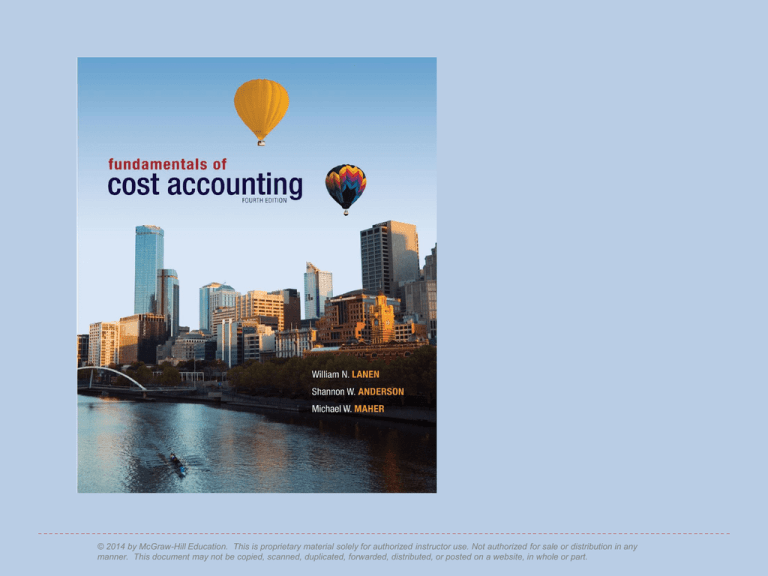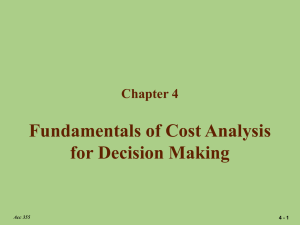
© 2014 by McGraw-Hill Education. This is proprietary material solely for authorized instructor use. Not authorized for sale or distribution in any
manner. This document may not be copied, scanned, duplicated, forwarded, distributed, or posted on a website, in whole or part.
Fundamentals of Cost Analysis
for Decision Making
Chapter 4
PowerPoint Authors:
Susan Coomer Galbreath, Ph.D., CPA
Charles W. Caldwell, D.B.A., CMA
Jon A. Booker, Ph.D., CPA, CIA
Cynthia J. Rooney, Ph.D., CPA
McGraw-Hill/Irwin
Copyright © 2014 by The McGraw-Hill Companies, Inc. All rights reserved.
Learning Objectives
LO 4-1 Use differential analysis to analyze decisions.
LO 4-2 Understand how to apply differential analysis
to pricing decisions.
LO 4-3 Understand several approaches for establishing
prices based on costs for long-run pricing decisions.
LO 4-4 Understand how to apply differential analysis to
production decisions.
LO 4-5 Understand the theory of constraints.
4-3
LO
4-1
Differential Analysis
LO 4-1 Use differential analysis to analyze decisions.
Differential Analysis
The process of estimating revenues and costs
of alternative actions available to decision makers
and of comparing these estimates to the status quo
Short Run
The period of time over which capacity will be
unchanged, usually one year
4-4
LO
4-1
Differential Costs
With two or more alternatives, costs that differ
among or between alternatives
Costs that change in response to an alternative
course of action
Differential costs differ between actions.
Alternative A
Alternative B
4-5
LO
4-1
Sunk Costs
Costs incurred in the past that cannot be
changed by present or future decisions
A sunk cost is NOT relevant for making decisions.
4-6
LO
4-1
Differential Costs versus Total
Costs
Information presented to management can show
the detailed costs that are included for making a
decision, or it can show just the differences
between alternatives, as follows.
Sales revenue
Variable costs
Contribution margin
Fixed costs
Operating profit
Status Quo
Alternative
Difference
$750
(250)
$500
(350)
$150
$900
(300)
$600
(350)
$250
$150
(50)
$100
-0$100
4-7
LO
4-2
Differential Analysis and
Pricing Decisions
LO 4-2 Understand how to apply differential
analysis to pricing decisions.
Variable costs must
always be covered.
Fixed costs must be
covered in the long run.
4-8
LO
4-2
Short-Run versus Long-Run
Pricing Decisions
Year 0
Year 1
Short-run
pricing decision:
Less than one year
Long-run
pricing decision:
Longer than one year
Pricing a one-time
special order.
Pricing a new product.
4-9
LO
4-2
Short-Run Pricing Decisions:
Special Orders
An order that will not affect other sales
and is usually a one-time occurrence
4-10
LO
4-2
Short-Run Pricing Decisions:
Special Orders
• U-Develop has received a one-time offer for 500 prints
at a special price of 40¢ per print ($200).
• The regular price is 50¢ and they have enough idle
capacity in the week to take the offer.
Sales for the week (5,000 prints at 50¢)
Variable costs, including paper, maintenance,
and usage payment to machine owner
(5,000 copies at 20¢)
Total contribution margin
Fixed costs (supplies, plus allocated costs
of the print shop)
Operating profit for the week
$2,500
1,000
$1,500
1,200
$ 300
4-11
LO
4-2
Short-Run Pricing Decisions:
Special Orders
Analysis of Special Order: U-Develop
Status
Quo:
Reject
Special
Offer
Comparison of Totals
Sales revenue
Variable costs
Total contribution
Fixed costs
Operating profit
Alternative Presentation: Differential Analysis
Differential sales, 500 at 40¢
Less: Differential costs, 500 at 20¢
Differential operating profit (before taxes)
$2,500
(1,000)
$1,500
(1,200)
$ 300
Alternative:
Accept
Special
Offer
Difference
$2,700
(1,100)
$1,600
(1,200)
$ 400
$200
(100)
$100
-0$100
$ 200
100
$ 100
4-12
LO
4-3
Long-Run Pricing Decisions
LO 4-3 Understand several approaches for establishing
prices based on costs for long-run pricing decisions.
Full cost is the total
cost to produce and
sell a unit.
Full costs are
relevant for the longterm pricing
decisions.
4-13
LO
4-3
Long-Run versus Short-Run
Pricing
In the short run,
differential costs may be
very low.
In the long run, differential
costs are higher than in
the short run.
4-14
LO
4-3
Cost Analysis for Pricing
In the long run an organization must cover
all variable and fixed costs – both
manufacturing and selling.
4-15
LO
4-3
Life-Cycle Product Costing and
Pricing
Product life-cycle is concerned with covering
costs in all categories of the life cycle.
R&D
Design
Manufacturing
Marketing and
distribution
Customer
service
Take back
(disposal)
4-16
LO
4-3
Target Costing from Target
Pricing
Target Price
The price based on customers’ perceived
value for the product and the price that
competitors charge
• What would a customer pay?
• How much profit do I need?
• Can I make it at this cost?
Target price – Desired profit = Target cost
4-17
LO
4-3
Legal Issues Relating to Costs
and Sales Price
Predatory Pricing
Practice of setting price below cost with the intent
to drive competitors out of business
Dumping
Exporting a product to another country at a price
below domestic cost
Price Discrimination
Practice of selling identical goods to different
customers at different prices
4-18
LO
4-3
Legal Issues Relating to Costs
and Sales Price
Peak-load Pricing
Practice of setting prices highest when the quantity
demanded for the product approaches capacity.
Price Fixing
Agreement among businesses to set prices at a
particular level.
4-19
LO
4-4
Use of Differential Analysis
for Production Decision
LO 4-4 Understand how to apply differential
analysis to production decisions.
Make or buy
Decision to make goods or services
internally or purchase them externally
Add or drop
a segment
Decision to add or drop a product
line or close a business unit
Product
choice
Decision on what products or
services to offer (product mix)
4-20
LO
4-4
Make-or-Buy Decisions
U-Develop’s current costs of developing prints:
Per unit
Costs directly traceable:
Direct materials
Direct labor
Variable manufacturing overhead
Fixed manufacturing overhead
Common costs allocated to this product line
Total costs
$0.05
0.12
.03
100,000
prints
$ 5,000
12,000
3,000
4,000
10,000
$34,000
This year’s expected volume is 100,000 prints,
so the full cost of processing a print is:
$34,000 ÷ 100,000 = $0.34
4-21
LO
4-4
Make-or-Buy Decisions
U-Develop received an offer from an outside
developer to process any number of prints for
25¢ each.
Should U-Develop accept this offer?
The accounting department
prepared cost analyses at
volume levels of 50,000 and
100,000 prints per year.
4-22
LO
4-4
Make-or-Buy Decisions
100,000
prints
Direct costs:
Direct materials
Labor
Variable overhead
Fixed overhead
Common costs
Total costs
a
b
Process
prints
$ 5,000
12,000
3,000
4,000
10,000b
$34,000
Outsource
processing
Difference
$25,000a $20,000 higher
-012,000 lower
-03,000 lower
-04,000 lower
10,000b
-0$35,000 $ 1,000 higher
100,000 units purchased at $0.25 = $25,000
These common costs remain unchanged for these volumes.
Because they do not change, they could be omitted from the analysis.
Differential costs increase by $1,000, so reject
alternative to buy.
4-23
LO
4-4
Make-or-Buy Decisions
50,000
prints
Direct costs:
Direct materials
Labor
Variable overhead
Fixed overhead
Common costs
Total costs
a
b
Process
prints
$ 2,500
6,000
1,500
4,000
10,000b
$24,000
Outsource
processing
Difference
$12,500a $10,000 higher
-06,000 lower
-01,500 lower
-04,000 lower
10,000b
-0$22,500 $ 1,500 lower
50,000 units purchased at $0.25 = $12,500
These common costs remain unchanged for these volumes.
Because they do not change, they could be omitted from the analysis.
Differential costs decrease by $1,500, so accept
alternative to buy.
4-24
LO
4-4
Opportunity Costs of Making
U-Develop’s expected volume is 100,000 prints.
Assume that the facilities used to process prints
could be used to offer a new service that would
provide a $2,000 incremental contribution.
Should U-Develop accept or
reject the alternative?
4-25
LO
4-4
Opportunity Costs of Making
Status quo: Alternative:
Process
Outsource
prints
processing
Total cost of 100,000 prints
Opportunity cost of using
facilities to process prints
Total costs, including
opportunity costs
a
Difference
$34,000
$35,000
$1,000 highera
2,000
$36,000
-0$35,000
2,000 lowera
$1,000 lowera
These indicate whether the alternative is higher or lower than the status quo.
Differential costs decrease by $1,000, so accept the
alternative.
4-26
LO
4-4
Add or Drop Decisions
U-Develop
Fourth Quarter Product Line Income Statement
Sales revenue
Cost of sales (all variable)
Contribution margin
Less fixed costs:
Rent
Salaries
Marketing and administrative
Operating profit (loss)
Total
Prints
Cameras
Frames
$80,000
53,000
$27,000
$10,000
8,000
$ 2,000
$50,000
30,000
$20,000
$20,000
15,000
$ 5,000
4,000
5,000
3,000
$15,000
1,000
1,000
500
$ (500)
2,000
2,500
1,500
$14,000
1,000
1,500
1,000
$ 1,500
4-27
LO
4-4
Add or Drop Decisions
U-Develop
Differential Analysis
Sales revenue
Cost of sales (all variable)
Contribution margin
Less fixed costs:
Rent
Salaries
Marketing and administrative
Operating profit (loss)
Status quo:
Keep prints
Alternative:
Drop prints
Difference
$80,000
53,000
$27,000
$70,000
45,000
$25,000
$10,000 decrease
8,000 decrease
$ 2,000 decrease
4,000
5,000
3,000
$15,000
4,000
4,000
2,750
$14,250
-01,000 decrease
250 decrease
$ 750 decrease
Profits decrease $750, so keep prints.
4-28
LO
4-4
Product Choice Decisions
Constraints
Activities, resources, or policies that limit the
attainment of an objective.
Contribution Margin per Unit of Scarce Resource
Contribution margin per unit of a particular input with
limited availability.
4-29
LO
4-4
Product Choice Decisions
U-Develop
Revenue and Cost Information
Metal Wood
frames frames
Price
Less: Variable costs per unit
Material
Labor
Overhead
Contribution margin per unit
Fixed costs
Manufacturing
Marketing and administrative
Total
$50
$80
8
8
4
$30
22
24
4
$30
$3,000
1,500
$4,500
4-30
LO
4-4
Product Choice Decisions
U-Develop
Revenue and Cost Information
Metal Wood
frames frames
Per unit:
Contribution margin
$ 30 $ 30
Machine hours required
÷ 0.5 ÷ 1.0
Contribution margin per machine hour $ 60 $ 30
Metal Frames have a higher contribution margin
per machine hour.
4-31
LO
4-4
Product Choice Decisions
Suppose U-Develop has 200 machine hours per
month available.
Metal
Wood
frames
Capacity
400
Contribution margin per unit
× $30
Total contribution margin
$12,000
Less: Fixed manufacturing costs
3,000
Less: Fixed marketing and admin. costs
1,500
Operating profit
$ 7,500
frames
200
× $30
$6,000
3,000
1,500
$1,500
Selling metal frames will result in higher profits than
selling wooden frames.
4-32
LO
4-5
The Theory of Constraints
LO 4-5 Understand the theory of constraints.
Theory of Constraints
Focuses on revenue and cost management when
faced with bottlenecks
Bottleneck
Operation where the work required limits production;
Bottleneck is the constraining resource
Throughput Contribution
Sales dollars minus direct materials costs and
variables such as energy and piecework labor
4-33
End of Chapter 4
4-34





